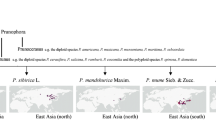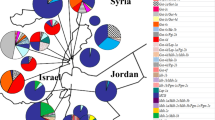Abstract
Many Central European weeds were introduced in conjunction with increasing agricultural activities during the Neolithic period. Others likely originated in situ during crop domestication and selection. Among the European weeds occurring primarily in cereal fields are three tetraploid members of the genus Bromus (Poaceae), Bromus secalinus L. associated with rye (Secale cereale), and B. grossus Desf. ex DC. and B. bromoideus (Lej.) Crép. both occurring with spelt (Triticum aestivum spp. spelta) and other winter cereals. All three species may have had their diploid ancestors in the Near and Middle East, but have apparently evolved in Europe. Bromus grossus and B. bromoideus are highly endangered and the former is designated as a European Union Flora–Fauna Habitat Directive target species, while the latter is extinct in the wild. In contrast B. secalinus has successfully spread worldwide. In this study, we compared morphological and genetic variation among the three species to clarify morphological uncertainties and their genetic distinctiveness. It is shown that B. bromoideus has evolved from within the B. grossus gene pool. It has been extirpated from the wild and is now only cultivated in a few botanical gardens, such as at Meise and Heidelberg. In addition we also hypothesize that B. secalinus evolved from B. grossus.





Similar content being viewed by others
References
Ainouche ML, Bayer RJ (1997) On the origins of the tetraploid Bromus species (section Bromus, Poaceae): insights from internal transcribed spacer sequences of nuclear ribosomal DNA. Genome 40:730–743
Barrett SCH (2000) Genetics and evolution of agricultural weeds. In: Liebman M (ed) Weed management in agroecosystems: ecological approaches. CRC Press, Boca Raton, pp 57–75
Bomble FW (2011) Kulturpflanzenmerkmale-eine kritische Betrachtung von Bromus sect. Bromus. Decheniana 164:33–39
Bonin A, Bellemain E, Eidesen PB, Pompanon F, Brochmann C, Taberlet P (2004) How to track and assess genotyping errors in population genetics studies. Molec Ecol 13:3261–3273
Bönsel D, Schmidt P, Barth UM (2014) Von Venuskamm, Finkensame und Hasenohr. Vom Aussterben bedrohte Ackerarten in Hessen. Hessen-Forst, Servicezentrum Forsteinrichtung und Naturschutz (FENA), Gießen
Bundesamt für Naturschutz (BfN) (2006, 2010) FloraWeb. Bonn. Available at: http://www.floraweb.de. Accessed 1 June 2015
Döll JC (1857) Flora des Grossherzogthums Baden. G. Braun'sche Hofbuchhandlung, Carlsruhe
Doyle J, Doyle JL (1987) Genomic plant DNA preparation from fresh tissue-CTAB method. Phytochem Bull Bot Soc Amer 19:11–15
Engelhardt M (2008) Untersuchung und Kartierung aktueller und historischer Vorkommen von Bromus grossus Desf. in Bayern. Bayerisches Landesamt für Umwelt, Augsburg, pp 1–21
Euro+Med Plantbase (2006–2014) Euro+Med Plantbase—the information resource for Euro-Mediterranean plant diversity. Available at: http://ww2.bgbm.org/EuroPlusMed/. Accessed 1 Dec 2014
Fortune PM, Pourtau N, Viron N, Ainouche ML (2008) Molecular phylogeny and reticulate origins of the polyploid Bromus species from section Genea (Poaceae). Amer J Bot 95:454–464
Gigot G (2013) Bromus bromoideus. The IUCN red list of threatened species 2013: e.T165228A5993241. doi:10.2305/IUCN.UK.2011-1.RLTS.T165228A5993241.e
Gong W, Chuan C, Dobes C, Fu CX, Koch MA (2008) Phylogeography of a living fossil: Pleistocene glaciations forced Ginkgo biloba L. (Ginkgoaceae) into two refuge areas in China with limited subsequent postglacial expansion. Molec Phylogen Evol 48:1094–1105
Gygax A, Montagnani C, Gargano D, Gigot G, Jogan N, Bernhardt KG, Dostalova A (2011) Bromus grossus. The IUCN red list of threatened species. Version 2014.1. Available at: http://www.iucnredlist.org. Accessed 1 Dec 2014
Hauke U (2003) Bromus grossus. In: Petersen B, Ellwanger G, Biewald G, Hauke U, Ludwig L, Pretscher P, Schröder E, Ssymank A (eds) Das europäische Schutzgebietssystem Natura 2000. Ökologie und Verbreitung von Arten der FFH-Richtlinie in Deutschland. Band 1: Pflanzen und Wirbellose. Bundesamt für Naturschutz, Bonn. Schriftenreihe Landschaftspflege Naturschutz 69(1):60–64
Hügin G (2001) Dicke Trespe (Bromus grossus). In: Fartmann T, Gunnemann H, Salm P, Schröder E (eds) Berichtspflichten in Natura 2000-Gebieten. Angew Landschaftsökol 42:90–93
Hügin G (2004) Wie lässt sich Bromus grossus von Bromus secalinus unterscheiden? Florist Rundbr 38:87–100
Huson DH, Bryant D (2006) Application of phylogenetic networks in evolutionary studies. Molec Biol Evol 23:254–267
Käsermann C, Moser DM (1999) Fiches Pratiques pour la Conservation. Plantes à Fleurs et Fougères. OFEFP, Berne
Keller M, Kollmann J, Edwards PJ (2000) Genetic introgression from distant provenances reduces fitness in local weed populations. J Appl Ecol 37:647–659
Koch M, Scheriau C, Betzin A, Hohmann N, Sharbel TF (2013) Evolution of cryptic gene pools in Hypericum perforatum: the influence of reproductive system and gene flow. Ann Bot (Oxford) 111:1083–1094
Kovach WL (2007) MVSP—a MultiVariate Statistical Package for Windows, ver. 3.1. Kovach Computing Services, Pentraeth
Kreuz A (1993) Einheimische oder fremde Pflanzen? Überlegungen zur Herkunft “potentieller Unkräuter” und ihrer Verbreitung zur Zeit der Bandkeramik. In: Kalisch A, Meurers-Balke J (eds) 7000 Jahre bäuerliche Landschaft: Entstehung, Forschung, Erhaltung. Rheinland-Verlag, Köln, pp 23–35
Lange D (1998) Bromus. In: Sebald O, Seybold S, Philippi G, Wörz A (eds) Die Farn- und Blütenpflanzen Baden-Württembergs, vol 7. Ulmer Verlag, Stuttgart, pp 470–510
Ludwig G, Schnittler M (1996) Red list of threatened plants in Germany (Rote Liste gefährdeter Pflanzen Deutschlands). Bundesamt für Naturschutz, Bonn
Meyer S, Wesche K, Leuchschner C, van Elsen T, Metzner J (2010) A new conservation strategy for arable plant vegetation in Germany—the project “100 fields for biodiversity”. Pl Breed Seed Sci 61:25–34
Meyer S, Wesche K, Krause B, Leuschner C (2013) Dramatic losses of specialist arable plants in Central Germany since the 1950s/60s—a cross-regional analysis. Diversity Distrib 19:1175–1187
Morgan V, Leon C (1992) Datasheets of flora species for revision of Appendix I of the Bern Convention. Vol. II. Nature and Environment. Council of Europe, Strasbourg
Moser DM, Gygax A, Bäumler B, Wyler N, Palese R (2002) Liste rouge des espèces menacées de Suisse. Fougères et plantes à fleurs. Office Fédéral de l'Environnement, des Forêts et du Paysage (OFEFP), Bern, Switzerland
Nei M, Li WH (1979) Mathematical-model for studying genetic variation in terms of restriction endonucleases. Proc Nat Acad Sci USA 76:5269–5273
Oja T (1998) Isoenzyxme diversity and phylogenetic affinities in the section Bromus of the grass genus Bromus (Poaceae). Biochem Syst Ecol 26:403–413
Oja T, Oja T, Zimmermann K (2010) Genetic variation of Bromus hordaceus s. lato (Poaceae) over its core distribution range. Ann Bot Fenn 47:161–174
R Development Core Team (2010) A language and environment for statistical computing. R Foundation for Statistical Computing, Vienna. Available at: http://www.r-project.org/. Accessed 1 May 2014
Rindos D (1983) The origin of agriculture. Academic Press, London, pp 1–325
Saarela JM (2007) Molecular phylogenetics of Bromus (Poaceae: Pooideae) based on chloroplast and nuclear DNA sequence data. Aliso 23:450–467
Scharrock S, Jones M (2009) Conserving Europe’s threatened plants. Progress towards target 8 of the global strategy for plant conservation. Botanic Gardens Conservation International, Richmond, pp 1–58
Schlüter PM, Harris SA (2006) Analysis of multilocus finger-printing data sets containing missing data. Molec Ecol Notes 6:569–572
Scholz H (1996) Ursprung und Evolution obligatorischer Unkräuter. Schr Genet Ressourcen 4:109–129
Scholz H (1970) Zur Systematik der Gattung Bromus L. Subgenus Bromus (Gramineae). Willdenowia 6:139–160
Scholz H (2008a) Some comments on the genus Bromus (Poaceae) and three new species. Willdenowia 38:411–422
Scholz H (2008b) Die Gattung Bromus (Poaceae) in Mitteleuropa. Synopse und tabellarischer Bestimmungsschlüssel. Kochia 3:1–18
Scholz H, Mos U (1994) Status und kurze Geschichte des ausgestorbenen Kulturgetreides Bromus mango E. Desv.—und die Genese des Bromus secalinus L. Flora 189:215–222
Schneider C, Sukopp H, Sukopp U (1994) Biologisch-ökologische Grundlagen des Schutz gefährdeter Segetalpflanzen. Schriftenr Vegetationskunde 26:348–356
Smith P (1973) Observation on some critical Bromegrasses. Watsonia 9:319–332
Smith PM (1981) Ecotypes and subspecies in annual brome grasses (Bromus, Gramineae). Bot Jahrb Syst Pflanzengesch Pflanzengeogr 102:97–509
Sonnberger M (2013) Fundmeldungen: Neufunde-Bestätigungen-Verluste. Bot Naturschutz Hessen 26:214
Tournay R (1968) Le Brome des Ardennes, “Bromus arduennsis”, et ses proches, B. secalinus et B. grossus. Bull Jard Bot Natl Belg 38:295–380
Vos P, Hogers R, Bleeker M, Reijans M, Lee TVD, Hornes M, Friters A, Jerina P, Paleman J, Kuiper M, Zabeau M (1995) AFLP: a new technique for DNA fingerprinting. Nucleic Acids Res 23:4407–4414
Wickler W (1968) Mimicry in plants and animals, Chap 4. McGraw-Hill, New York
Willerding U (1986) Zur Geschichte der Unkräuter Mitteleuropas. Göttinger Schriften zur Vor- und Frühgeschichte22. Wachholtz, Neumünster, pp 1–382
Wörz A, Hölzer A, Thiv M (2014) Aktuelle Verbreitungskarten der Farn- und Blütenpflanzen Baden-Württembergs. NHMS, Stuttgart. Available at: http://www.flora.naturkundemuseum-bw.de. Accessed 1 Dec 2014
Acknowledgments
We thank several anonymous reviewers for comments on earlier versions of the manuscript and Anja Landau for support with AFLP analysis. In particular major editorial input from the handling editor, Walter Durka, has been greatly acknowledged.
Author information
Authors and Affiliations
Corresponding author
Ethics declarations
Conflict of interest
The authors declare that they have no conflict of interest.
Additional information
Handling editor: Walter Durka.
Electronic supplementary material
Below is the link to the electronic supplementary material.
606_2016_1279_MOESM4_ESM.pdf
Online Resource 4. Results of the principal coordinate analysis (PCoA) of morphometric characters from the complete dataset (PDF 144 kb)
Information on Electronic Supplementary Material
Information on Electronic Supplementary Material
Online Resource 1. Complete list of accessions analysed.
Online Resource 2. Detailed morphological dataset.
Online Resource 3. Scores and means of individual/accession-based measurements.
Online Resource 4. Results of the principal coordinate analysis (PCoA) of morphometric characters from the complete dataset.
Online Resource 5. AFLP scoring table.
Rights and permissions
About this article
Cite this article
Koch, M.A., Meyer, N., Engelhardt, M. et al. Morphological and genetic variation of highly endangered Bromus species and the status of these Neolithic weeds in Central Europe. Plant Syst Evol 302, 515–525 (2016). https://doi.org/10.1007/s00606-016-1279-5
Received:
Accepted:
Published:
Issue Date:
DOI: https://doi.org/10.1007/s00606-016-1279-5




